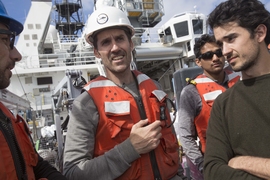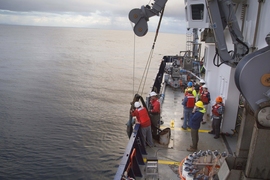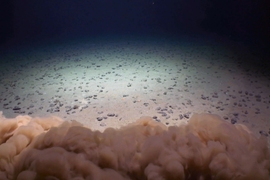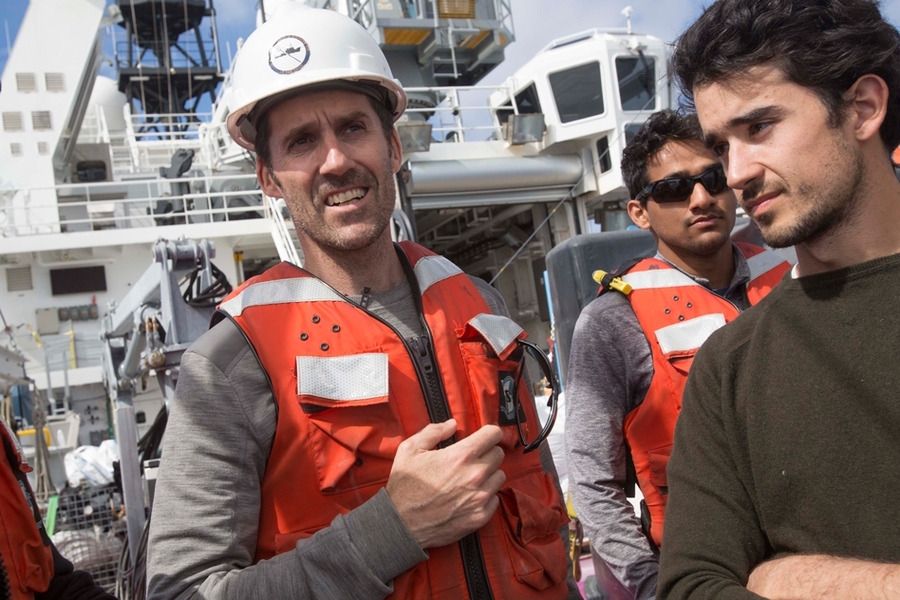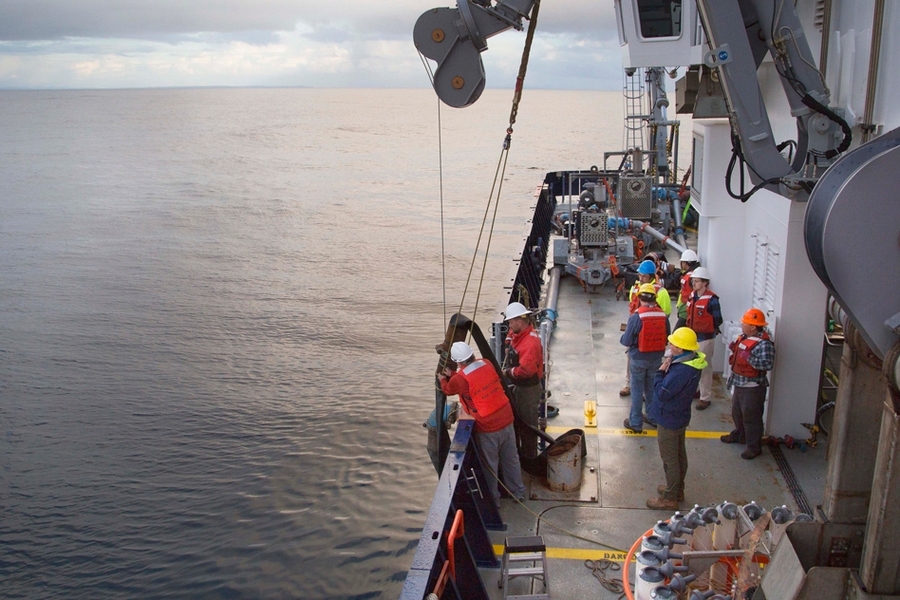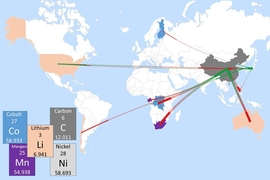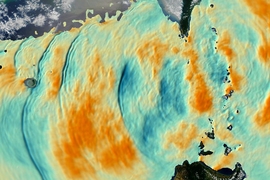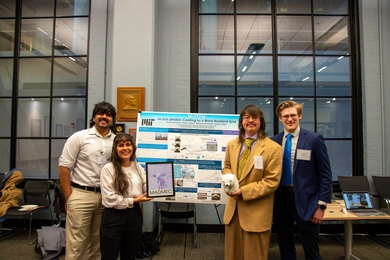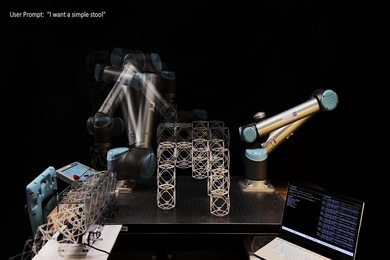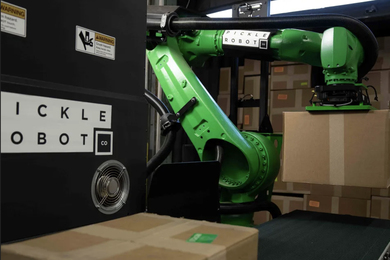Resting atop Thomas Peacock’s desk is an ordinary-looking brown rock. Roughly the size of a potato, it has been at the center of decades of debate. Known as a polymetallic nodule, it spent 10 million years sitting on the deep seabed, 15,000 feet below sea level. The nodule contains nickel, cobalt, copper, and manganese — four minerals that are essential in energy storage.
“As society moves toward driving more electric vehicles and utilizing renewable energy, there will be an increased demand for these minerals, to manufacture the batteries necessary to decarbonize the economy,” says Peacock, a professor of mechanical engineering and the director of MIT’s Environmental Dynamics Lab (END Lab). He is part of an international team of researchers that has been trying to gain a better understanding the environmental impact of collecting polymetallic nodules, a process known as deep-sea mining.
The minerals found in the nodules, particularly cobalt and nickel, are key components of lithium-ion batteries. Currently, lithium-ion batteries offer the best energy density of any commercially available battery. This high energy density makes them ideal for use in everything from cellphones to electric vehicles, which require large amounts of energy within a compact space.
“Those two elements are expected to see a tremendous growth in demand due to energy storage,” says Richard Roth, director of MIT’s Materials Systems Laboratory.
While researchers are exploring alternative battery technologies such as sodium-ion batteries and flow batteries that utilize electrochemical cells, these technologies are far from commercialization.
“Few people expect any of these lithium-ion alternatives to be available in the next decade,” explains Roth. “Waiting for unknown future battery chemistries and technologies could significantly delay widespread adoption of electric vehicles.”
Vast amounts of specialty nickel will be also needed to build larger-scale batteries that will be required as societies look to shift from an electric grid powered by fossil fuels to one powered by renewable resources like solar, wind, wave, and thermal.
“The collection of nodules from the seabed is being considered as a new means for getting these materials, but before doing so it is imperative to fully understand the environmental impact of mining resources from the deep ocean and compare it to the environmental impact of mining resources on land,” explains Peacock.
After receiving seed funding from MIT’s Environmental Solutions Initiative (ESI), Peacock was able to apply his expertise in fluid dynamics to study how deep-sea mining could affect surrounding ecosystems.
Meeting the demand for energy storage
Currently, nickel and cobalt are extracted through land-based mining operations. Much of this mining occurs in the Democratic Republic of the Congo, which produces 60 percent of the world’s cobalt. These land-based mines often impact surrounding environments through the destruction of habitats, erosion, and soil and water contamination. There are also concerns that land-based mining, especially in politically unstable countries, might not be able to supply enough of these materials as the demand for batteries rises.
The swath of ocean located between Hawaii and the West Coast of the United States — also known as the Clarion Clipperton Fracture Zone — is estimated to possess six times more cobalt and three times more nickel than all known land-based stores, as well as vast deposits of manganese and a substantial amount of copper.
While the seabed is abundant with these materials, little is known about the short- and long-term environmental effects of mining 15,000 feet below sea level. Peacock and his collaborator Professor Matthew Alford from the Scripps Institution of Oceanography and the University of California at San Diego are leading the quest to understand how the sediment plumes generated by the collection of nodules from the seabed will be carried by water currents.
“The key question is, if we decide to make a plume at site A, how far does it spread before eventually raining down on the sea floor?” explains Alford. “That ability to map the geography of the impact of sea floor mining is a crucial unknown right now.”
The research Peacock and Alford are conducting will help inform stakeholders about the potential environmental effects of deep-sea mining. One pressing matter is that draft exploitation regulations for deep-sea mining in areas beyond national jurisdiction are currently being negotiated by the International Seabed Authority (ISA), an independent organization established by the United Nations that regulates all mining activities on the sea floor. Peacock and Alford’s research will help guide the development of environmental standards and guidelines to be issued under those regulations.
“We have a unique opportunity to help regulators and other concerned parties to assess draft regulations using our data and modeling, before operations start and we regret the impact of our activity,” says Carlos Munoz Royo, a PhD student in MIT’s END Lab.
Tracking plumes in the water
In deep-sea mining, a collector vehicle would be deployed from a ship. The collector vehicle then travels 15,000 feet down to the seabed, where it vacuums up the top four inches of the seabed. This process creates a plume known as a collector plume.
“As the collector moves across the seabed floor, it stirs up sediment and creates a sediment cloud, or plume, that’s carried away and distributed by ocean currents,” explains Peacock.
The collector vehicle picks up the nodules, which are pumped through a pipe back to the ship. On the ship, usable nodules are separated from unwanted sediment. That sediment is piped back into the ocean, creating a second plume, known as a discharge plume.
Peacock collaborated with Pierre Lermusiaux, professor of mechanical engineering and of ocean science and engineering, and Glenn Flierl, professor of Earth, atmospheric, and planetary sciences, to create mathematical models that predict how these two plumes travel through the water.
To test these models, Peacock set out to track actual plumes created by mining the floor of the Pacific Ocean. With funding from MIT ESI, he embarked on the first-ever field study of such plumes. He was joined by Alford and Eric Adams, senior research engineer at MIT, as well as other researchers and engineers from MIT, Scripps, and the United States Geological Survey.
With funding from the UC Ship Funds Program, the team conducted experiments in consultation with the ISA during a weeklong expedition in the Pacific Ocean aboard the U.S. Navy R/V Sally Ride in March 2018. The researchers mixed sediment with a tracer dye that they were able to track using sensors on the ship developed by Alford’s Multiscale Ocean Dynamics group. In doing so, they created a map of the plumes’ journeys.
The field experiments demonstrated that the models Peacock and Lermusiaux developed can be used to predict how plumes will travel through the water — and could help give a clearer picture of how surrounding biology might be affected.
Impact on deep-sea organisms
Life on the ocean floor moves at a glacial pace. Sediment accumulates at a rate of 1 millimeter every millennium. With such a slow rate of growth, areas disturbed by deep-sea mining would be unlikely to recover on a reasonable timescale.
“The concern is that if there is a biological community specific to the area, it might be irretrievably impacted by mining,” explains Peacock.
According to Cindy Van Dover, professor of biological oceanography at Duke University, in addition to organisms that live in or around the nodules, other organisms elsewhere in the water column could be affected as the plumes travel.
“There could be clogging of filter feeding structures of, for example, gelatinous organisms in the water column, and burial of organisms on the sediment,” she explains. “There could also be some metals that get into the water column, so there are concerns about toxicology.”
Peacock’s research on plumes could help biologists like Van Dover assess collateral damage from deep-sea mining operations in surrounding ecosystems.
Drafting regulations for mining the sea
Through connections with MIT’s Policy Lab, the Institute is one of only two research universities with observer status at the ISA.
“The plume research is very important, and MIT is helping with the experimentation and developing plume models, which is vital to inform the current work of the International Seabed Authority and its stakeholder base,” explains Chris Brown, a consultant at the ISA. Brown was one of dozens of experts who convened on MIT’s campus last fall at a workshop discussing the risks of deep-sea mining.
To date, the field research Peacock and Alford conducted is the only ocean dataset on midwater plumes that exists to help guide decision-making. The next step in understanding how plumes move through the water will be to track plumes generated by a prototype collector vehicle. Peacock and his team in the END Lab are preparing to participate in a major field study using a prototype vehicle in 2020.
Peacock and Lermusiaux hope to develop models that give increasingly accurate predictions about how deep-sea mining plumes will travel through the ocean. They will continue to interact with academic colleagues, international agencies, NGOs, and contractors to develop a clearer picture of deep-sea mining’s environmental impact.
“It’s important to have input from all stakeholders early in the conversation to help make informed decisions, so we can fully understand the environmental impact of mining resources from the ocean and compare it to the environmental impact of mining resources on land,” says Peacock.
